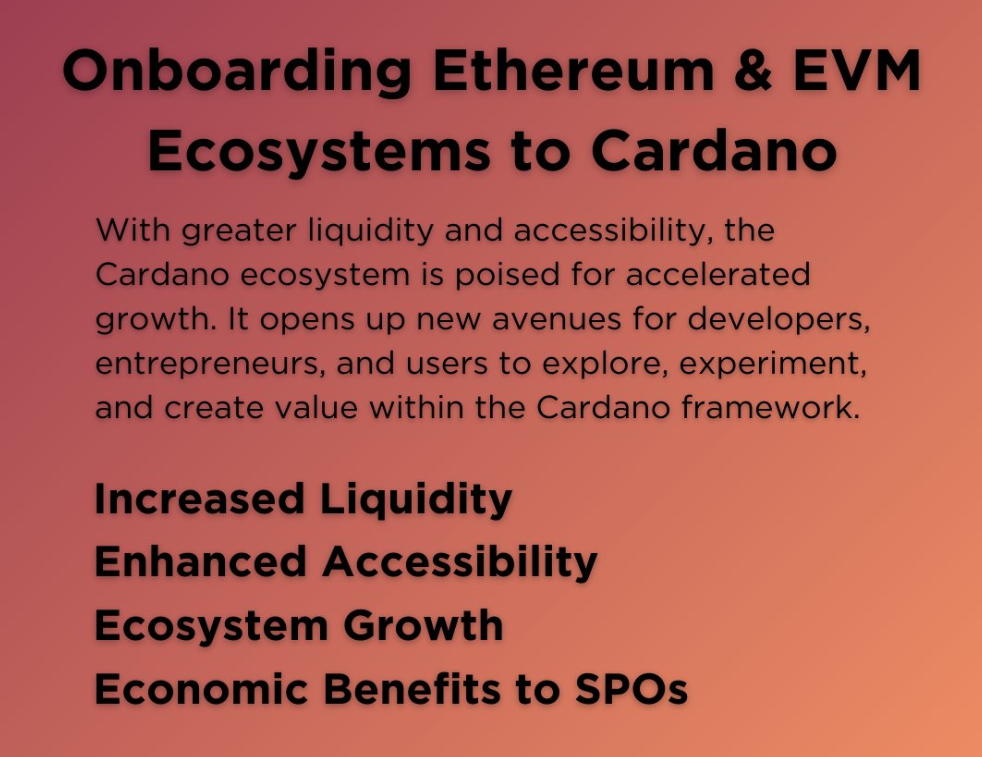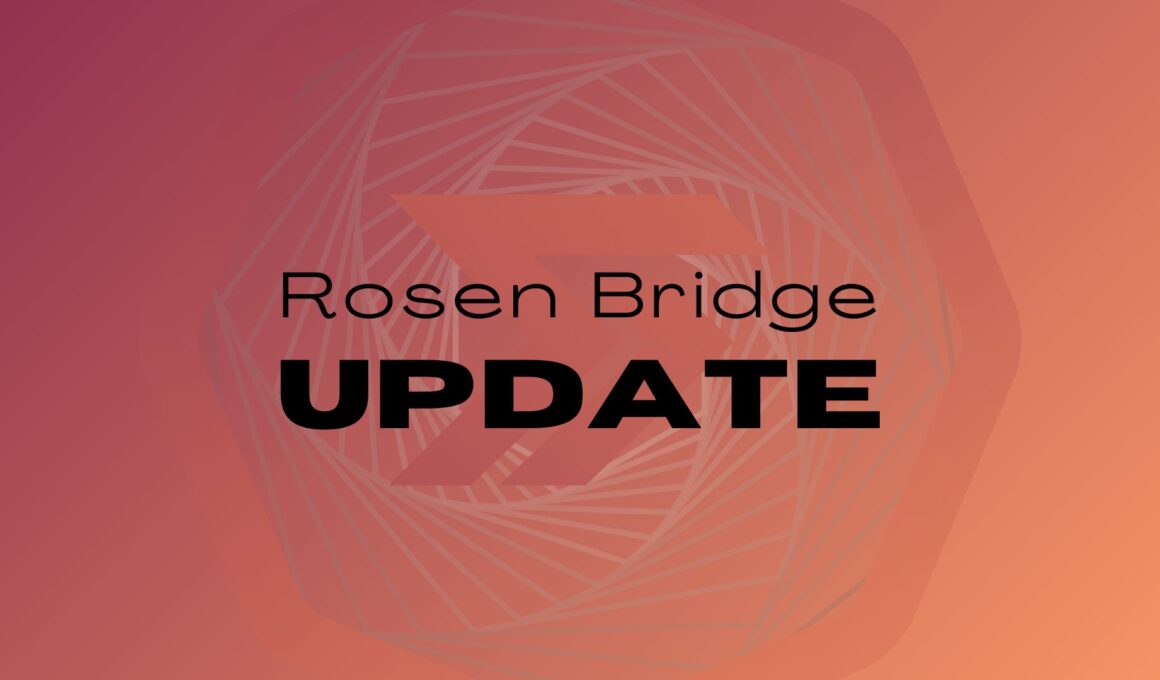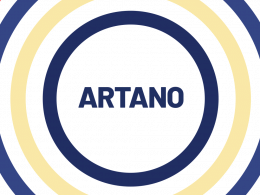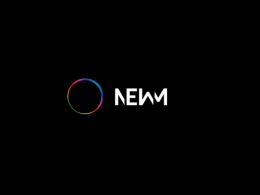Onboarding Ethereum and EVM Ecosystems to Cardano
Cross-chain interoperability is one of the most significant innovations in the blockchain world. It breaks the barriers of traditionally isolated blockchain ecosystems, thereby allowing seamless communication and transfer of assets between networks. This not only enhances the fluidity of asset transfer but also creates a more collaborative and inclusive blockchain environment. Developers can build applications that span multiple blockchains, leveraging the strengths of each. Similarly, users get to enjoy a seamless experience where they can move assets across networks without the need for intermediaries, which enhances security by reducing reliance on third parties. The importance of such interoperability is akin to the early days of the internet; where isolated networks began to converge into the interconnected web we know today.
While cross-chain interoperability is key to unlocking the true potential of blockchain by bridging these digital islands, we aren’t there yet. It’s a challenge that requires tackling the complexities that arise from the diverse underlying architectures of each network. Sidechains and smart contracts are instrumental in addressing the long-standing challenge of blockchain isolation, acting as bridges and providing the necessary logic for asset and data transfer.
In this article, we explore Rosen Bridge and it’s approach towards enabling a unified blockchain ecosystem and from a Cardano perspective.
The Challenge
In the current blockchain landscape, Cardano native tokens face a significant hurdle of high centralized exchange fees. These fees not only hinder ecosystem growth but also concentrate value in the hands of centralized entities, which goes against the key ethos of decentralization. For top-tier exchange listings, a single project can incur listing fees exceeding $200,000 USD, excluding market-making costs. This liquidity drain stifles the growth of Cardano projects.
Moreover, the vision of a cross-chain future, where communities collaborate and benefit from diverse ecosystem tools, is hampered by these financial and structural limitations. According to Chainalysis, an year like 2022 saw over $2 billion USD in cryptocurrency stolen from cross-chain bridges due to centralization risks and poor design, which further emphasizes the need for a secure and decentralized approach in cross-chain interactions.
A Journey Beyond Chains: Revolutionizing Cross-Chain Interoperability with Rosen Bridge
Arguably one of the most promising developments in the cross-chain solutions space, Rosen Bridge is specifically designed to address the challenges of cross-chain asset transfers. This open-source protocol is currently in development, testing its first bridge to Cardano, and is expected to revolutionize the way assets are moved across blockchains. By leveraging Ergo’s capabilities, Rosen Bridge aims to facilitate secure and efficient coin and token transfers, which is a game-changer for users and developers alike.
The significance of Rosen Bridge lies in its approach to security and efficiency. It operates without the need for deploying smart contracts on other chains, which simplifies the process and reduces potential points of failure. The bridge’s architecture, comprising Watchers and Guards, ensures a high level of security and functionality, making it a robust solution for cross-chain transfers.
Moreover, the Rosen Bridge’s design allows for the addition of new chains through independent modules, enhancing scalability and user safety. The Rosen Token (RSN) plays a crucial role in the operation of the bridge, serving as a mechanism for sybil resistance, fee distribution, and access to bridge services. This thoughtful design prioritizes the success of user transactions by waiting for a sufficient number of confirmations, ensuring that the bridge is not only innovative but also user-centric.
Here’s a quick walkthrough of the Rosen Bridge solution and how it works:
- Connecting Ecosystems: Initially, the Rosen Bridge connects the Cardano and Ergo ecosystems. However, the same infrastructure can extend to connect Cardano with other ecosystems, including Ethereum and other EVM chains.
- Bypassing Centralized Exchanges: By linking Cardano with Ethereum and EVM ecosystems, the Rosen Bridge enables secure, decentralized growth and liquidity. It circumvents the prohibitive costs associated with centralized exchanges, allowing Cardano projects to thrive without draining liquidity.
- Open Source and Secure: The Rosen Bridge is an open-source solution. Its code is already available for scrutiny and improvement. Unlike centralized exchanges, it prioritizes security and decentralization.
- Ergo-Centric Logic: The smart contracts reside on the Ergo blockchain, while only a multi-sig is needed on the other chain. This ergo-centric approach simplifies the process and ensures scalability.
- Hub for Cross-Chain Interoperability: As the Rosen Bridge expands, it aims to become a hub for cross-chain interoperability. Imagine seamless collaboration between Cardano, Ethereum, and other ecosystems, fostering liquidity, innovation, and community growth.
For a complete understanding of Rosen Bridge, it’s design, and how token transfers between Ergo and different chains work, you can watch this educative video by Joseph Armeanio, Ergo’s business manager.
Project Roadmap
The Rosen Bridge project is currently in active development, with the teamworking to bring its vision to fruition. Progress is underway on multiple fronts, including research, development, and testing, as the project strives to pioneer groundbreaking solutions in cross-chain interoperability. The work involved is divided into the following phases:
| Stage | Description |
|---|---|
| Research | In-depth analysis of existing EVM bridge solutions, identifying potential security risks, and understanding the unique requirements of the Cardano and Ethereum ecosystems. |
| Preparation | Setting up the necessary infrastructure and tools for development, including software licenses, server costs, and other technical resources. |
| Design | Development of architectural plans and protocols for the bridge, ensuring robust security and efficient functionality. This includes the creation of technical specifications and design documents. |
| Module Development | Building core components such as scanners, verification methods, and communication channels. This involves coding, debugging, and initial unit testing. |
| Integration Testing | Ensuring that individual modules work seamlessly together. This includes the allocation of resources for comprehensive testing environments. |
| Quality Assurance | Rigorous testing to identify and fix bugs, and to validate the functionality of the modules against the design specifications. |
| Development of Multisig Mechanism | Creating a secure multi-signature system for both hot and cold wallets, crucial for enhancing the security of cross-chain transactions. |
| Security Testing | Extensive testing of the multisig system to ensure it is hack-proof and meets high-security standards. |
| Integration | Seamlessly integrating the multisig system with the existing bridge infrastructure. |
| Code Integration | Merging the developed modules with the existing Rosen Bridge codebase. This includes ensuring compatibility and efficient performance. |
| UI/UX Development | Designing and implementing user interfaces and user experiences for both watchers and guards, enhancing usability and accessibility. |
| Final Testing | Conducting end-to-end tests to ensure all components work harmoniously. |
| Code audits | Performing audits on the code to identify potential vulnerabilities and ensure compliance with best practices. |
| Testnet Deployment | Launching the bridge on testnets to simulate real-world usage |
Project Funding
According to the Rosen Bridge, the initial public release for the project will be available within six months of funding. To achieve this, the team requested a total funding of 550,000 AD. and received overwhelming support from the community. These funds will cater for the project development costs for six months until the public launch date, as per these milestones:
| Milestone | Description | Budget (ADA) |
|---|---|---|
| Milestone 1 | In-depth research, infrastructure setup, architectural planning | 150,000 |
| Milestone 2 | Building and testing core components | 100,000 |
| Milestone 3 | Development and integration of multisig system | 100,000 |
| Milestone 4 | Merging developed modules into existing codebase | 100,000 |
| Milestone 5 | Comprehensive testing and deployment on testnets | 50,000 |
| Milestone 6 | Final deployment on the main Cardano network | 50,000 |
Adding Value to the Ecosystem

The investment in Rosen Bridge represents a commitment to broadening the horizons of Cardano, enabling it to seamlessly interact with other major blockchain networks. This interconnectivity is crucial for several reasons:
- Increased Liquidity: By connecting with Ethereum and other EVM chains, Cardano native tokens gain access to a much larger pool of liquidity. This is vital for the growth of DeFi projects within the Cardano ecosystem, as it allows for more fluid and dynamic financial interactions.
- Enhanced Accessibility: The bridge reduces the barriers to entry for users and developers from other ecosystems. This inclusivity fosters a more diverse and robust community, leading to innovative projects and collaborations.
- Ecosystem Growth: With greater liquidity and accessibility, the Cardano ecosystem is poised for accelerated growth. It opens up new avenues for developers, entrepreneurs, and users to explore, experiment, and create value within the Cardano framework.
- Economic Benefits for Stake Pool Operators (SPOs): The bridge provides additional revenue streams for SPOs, enhancing the overall health and stability of the Cardano network. The more ecosystems are connected to Rosen, we will see more income opportunities.This is crucial for long-term sustainability and growth.
The Rosen Bridge Team
The team behind Rosen Bridge project consists a group of exceptionally talented individuals in the Cardano community. Their expertise and solid reputation demonstrates that they’re more than capable of delivering the project. Forming the core team is:
- Mohammad Hasan Samadani (Lead Developer): Lead developer for the Rosen Bridge project + SuSy Bridge (Wormhole). Holds a PhD in computer science and has over 12 years experience in security, software development, and team management. Designed various applications for the Ergo ecosystem.
- Joseph Armeanio (Project Lead): Currently a board member and business development manager of the Ergo Foundation.
- Daniel Friedman (Education and User Onboarding Lead): Currently an advisor to the Ergo Foundation and Co-Founder of zenGate Global. Previously, he was part of the IOHK early-founding team that helped launch the Cardano blockchain.
- Theodore Morisis (SPO and Watchers Coordination Lead): Operator of the Chef Stake Pool, community educator and Cardano Ambassador. Theodore also works as a community manager for zenGate Global.
- Alexander Chepurnoy (Code Auditing Support): Co-founder of the Ergo Blockchain and smartcontract.com (now Chainlink). One of the first employees at IOHK, as a researcher fellow and manager for the Scorex Project. Active in blockchain since 2011 and has 20+ academic papers contributed to the industry.
- Sam Lambert (Project Management and User Onboarding Support): Co-Founder of zenGate Global. Previously, worked as a management consultant at Oliver Wyman and helped set up the Global Digital Assets practice. Worked with some of the largest banks, insurance and telecommunications companies around the world.
This team has strong experience in the blockchain sector and has delivered a number of successful products for the Ergo and Cardano ecosystems. The team are strong advocates of open-source technology and have notable examples of projects to demonstrate it, including:
- Ergo Blockchain, SCOREX and smarcontract.com: Alexander Chepurnoy is the core developer for the Ergo blockchain and founded various other projects. Previously worked as a researcher for IOHK.
- ERGO mining softwares, Stratum server, and ergopool – developed by Mohammad Hasan Samadani
- Delivery of the Rosen Bridge framework between Ergo and Cardano
Looking into the Future
Cross-chain interoperability is more than just a technical implementation; it’s a paradigm shift that aligns with the ethos of decentralization. Cardano has already formed strategic partnerships and collaborations, such as with Wanchain and Maestro, which are testament to its commitment to building a more connected and efficient blockchain ecosystem. With the Cardano community providing overwhelming support to Rosen Bridge, it’s a reinstatement of our shared vision of a decentralized future where value and information flow freely across networks.
In the blockchain multiverse, think of Rosen Bridge as a cosmic handshake between two galaxies, Cardano and Ethereum, each possessing unique strengths but have remained isolated. With Rosen Bridge, projects can take advantage of the best of the two worlds and liquidity will flow freely, making the truly decentralized dream a reality.
For more details, check out the recently approves Catalyst Fund 11 Proposal on Onboarding Ethereum & EVM Ecosystems to Cardano via Rosen Bridge1. 🌉🌟










